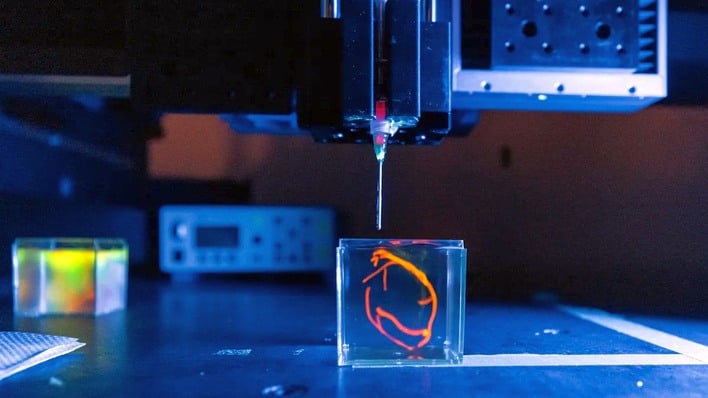Scientists 3D Print Human Heart Tissue Using Stem Cells And The Implications Are Huge
A common trope in science fiction, especially cyberpunk fiction, involves custom-grown replacement organs based on the recipient's own flesh. We're not there yet as a species—and in fact still a good ways off—but we just made a huge step in that direction. Scientists at Stanford University have managed to use advanced "bioprinting" techniques to print a small piece of bio-engineered human heart tissue.

We can use transplants from humans or even other animals, though, right? What's the point of this? While it's true that transplants are done every day, those components can be rejected by the body as much as 20 or even 30 years later. That may not be so much of a concern in the body of a 60-year-old heart patient, but for young children born with heart defects, that puts a terrifyingly short timeline on their lives.
Using modern 3D printing methods, the team was able to manufacture thicker tissues one layer at a time, manually placing the exact type of cells required at the right spots. This works well for creating complex tissues like those found in the human heart where the 3D structure is critical to its function. Of course, there are major challenges to this approach, too.
Ultimately, what the scientists managed to create is a tube roughly 2 inches long and about a quarter-inch in diameter. The tissues have the ability to "pump" on their own through rhythmic contraction and expansion, just like human heart tissue. While the vein-like tube that the team created isn't useful at this stage, it's an important step toward manufacturing larger tissues that could be used in the body.
To be completely clear, this is real human heart tissue constructed from living stem cells. The amount of tissue that the lab created is too small to be used for anything practical yet, but these methods could result in replacement heart valves or other critical internal organs once scaled up.

Above and top: Andrew Brodhead / Stanford University
We can use transplants from humans or even other animals, though, right? What's the point of this? While it's true that transplants are done every day, those components can be rejected by the body as much as 20 or even 30 years later. That may not be so much of a concern in the body of a 60-year-old heart patient, but for young children born with heart defects, that puts a terrifyingly short timeline on their lives.
Bioprinting is nothing new, and neither is creating specific human tissue from stem cells. The breakthrough in this case is that the researchers—Mark Skylar-Scott and his team—were able to use 3D printing techniques to build complex, layered heart tissue in a structure much thicker than the typical "scaffold" method. Human organs are not "monolithic balls of cells," but rather complex structures that are difficult to replicate.
Ultimately, what the scientists managed to create is a tube roughly 2 inches long and about a quarter-inch in diameter. The tissues have the ability to "pump" on their own through rhythmic contraction and expansion, just like human heart tissue. While the vein-like tube that the team created isn't useful at this stage, it's an important step toward manufacturing larger tissues that could be used in the body.


